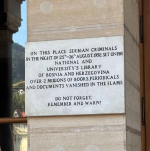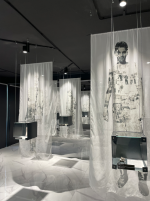
Post-conflict memory and war traces in Bosnia & Herzegovina
As part of NIOD’s running pilot project on the Digital Research Environment (DRE) for Former Yugoslavia Wars, a small group of NIOD-researchers visited Bosnia and Herzegovina in June. The purpose of this 7-day trip was for the team to gain a deeper understanding of the Yugoslav wars of the 1990s and how the memory of the wars has been shaped in the aftermath, with particular attention to the Srebrenica genocide and the siege of Sarajevo.
Besieged Sarajevo
Starting off the trip in Bosnia and Herzegovina’s capital Sarajevo, we saw how the city displays a layered historical narrative through its Ottoman quarter, Austrian-Hungarian quarter and parts that were built during the existence of Yugoslavia. Situated in an oblong valley, the hills that surround Sarajevo were controlled by Bosnian-Serb forces during the wars in the 1990s when the city was besieged for a total of 1425 days, the longest siege in modern warfare history.
The fieldwork started right as we got off the plane at Sarajevo Airport, which acted as a strategic location for humanitarian aid delivery and airlift operations during the siege under the United Nations Protection Force (UNPROFOR) after the handover from the Yugoslav People’s Army (JNA) in June 1992. Our first stop was the “Objekt BD”, the codename for the tunnel that was built by the Bosnian Army to link the occupied city of Sarajevo to Bosnian-held territory on the other side of Sarajevo Airport. Now called the Tunnel of Hope, it allowed for the supply of food, military supplies, humanitarian aid, and for people to get out.
War remnants remain visible throughout the city. On some streets you stumble upon “Sarajevo roses”, remnants of the impact of shelling on the concrete that were painted red after the war had ended. There are plaques with descriptions of events that took place during the siege on buildings and streets, such as the city hall which bears a plaque on its entrance that refers to the destruction the then National and University Library at the start of the siege. Over two million books were lost despite the building having no military function.

On the square opposite the city hall and the river Miljacka that passes through Sarajevo, there is an open-air photo exhibition about Potočari, a village in the municipality of Srebrenica where Bosniaks sought protection by UNPROFOR Dutchbat in the days leading up to the Srebrenica genocide, while the separation, detention, and deportation of men and women began. The photos are accompanied by quotes from victims, soldiers, witnesses, authors, and files from the International Criminal Tribunal for the Former Yugoslavia (ICTY).


The Curation of War
During the trip, we visited war museums and memorial centres in different cities. What stood out was that, although all the museums were curated by individuals who directly experienced or were affected by the specific war addressed, each museum used distinct approaches to curation and storytelling. Some used timelines and precise developments as a starting point, some used oral history accounts of survivors, some focused on the aftermath of the wars and the question of mass graves and excavations, and some relied more on personal stories relating to images and objects rather than a historical explanation of what happened during the war.
However, one common practice was present across the museums: the use of personal belongings and photographs of victims in the exhibition spaces as a way of affirming that they once existed. During our visit to the Srebrenica Memorial Centre, their archivists shared that most of the personal belongings in their collection were acquired in recent years. As the older generations are gradually passing away, they find importance in handing over belongings they have kept of their families who were victims of the genocide to the memorial centre to allow their proof of existence to last.
At the Memorial Centre, we met the oral history team that has now recorded over 700 people's video testimonies and stories of Srebrenica. In one of their exhibitions titled ‘The Lives Behind the Fields of Death’, personal items that have been donated for safekeeping are exhibited in tandem with snippets of 100 video testimonies about the items and their former owners, in an effort to affirm that they existed and to combat genocidal denial.

Whether the traces of war are merely marks that remain visible until this day, or curated exhibits of the past, they stand as enduring remnants of events of the Yugoslav wars. Sarajevo becomes a space in which memory is actively practiced by highlighting traces of the siege. The memorial centre focuses on oral history as a method of remembering, allowing individuals to share their experiences. Through museums’ object-centered approach to storytelling, personal stories and personal belongings of loved ones become connected and their existence more tangible. These approaches collectively work toward a common practice of making the past visible and affirming the existence of the victims of war, while allowing future generations to keep remembering.
